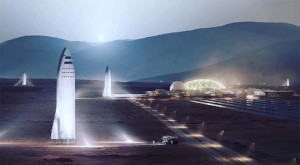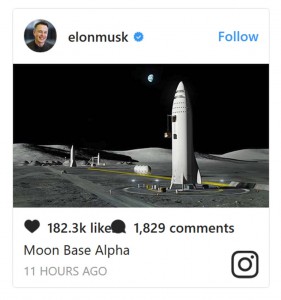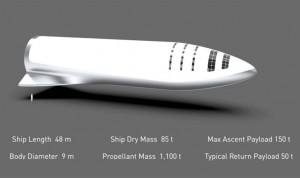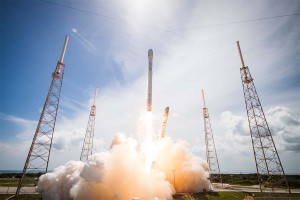
An artist's rendering of SpaceX BFR spaceships on Mars. While the sky is blue and sunsets are red on Earth, it's the other way around on Mars.
Elon Musk is clearly out to change the way we travel, both where we go and how we get there. The visionary entrepreneur has laid out a series of plans for his SpaceX rocket company that would not only set the stage for colonizing Mars but speed up the process of getting to just about any place on Earth.
Musk has revealed plans for a next-generation spacecraft – dubbed BFR, for “Big Falcon Rocket” – that could be used to go from New York to Shanghai, for example, in less than a half-hour. With the internal nickname, “Big Fucking Rocket,” it would also be the vehicle to get man back to the moon and even Mars, Musk announcing plans to land two cargo ships on the Red Planet in 2022, and astronauts two years later.
“That’s not a typo — although it is aspirational,” said the South African-born Musk, during a presentation at the International Astronautical Congress, or IAC, in Australia, early today.
Musk has a seeming fixation on both cleaning up and speeding up transportation, while also reaching places man has never gone before.
 His battery-electric company Tesla recently launched its first mainstream, long-range vehicle, the Model 3, and claims to have so many backorders it will take until 2019 just to catch up with the reservations already on the books.
His battery-electric company Tesla recently launched its first mainstream, long-range vehicle, the Model 3, and claims to have so many backorders it will take until 2019 just to catch up with the reservations already on the books.
(Tesla getting ready to reveal first battery-electric semi truck. Click Here for more.)
Then there’s the Boring Company, a newly launched venture that is focused on creating tunnels in cities like Los Angeles where motorists could use a way to get around endemic traffic snarls. Earlier this year, Musk announced preliminary plans for a 230-mile tunnel that would allow travelers to get from New York to Washington, D.C. in just 29 minutes.
That would be roughly the time it would take for the BFR rocket to get travelers from one place to another pretty much anywhere on the planet, Musk told those gathered at the IAC.
Unlike conventional rockets – or even the boosters used for the old NASA Space Shuttle, the entire rocket, including the booster stage and the upper stage containing passengers, would be reusable. SpaceX has already made it a routine part of its business to return the first stage of its Falcon 9 rocket after launching satellites into orbit and cargo to the International Space Station.
The Falcon 9, the company’s current transporter, measures 12 feet in diameter by 230 feet in length and can carry a payload of up to 15 tons. The BFR will measure 30 by 348 feet, or about 15 feet shorter than the Saturn V when equipped to take astronauts to the moon. But the two-stage configuration will have significantly more cargo capacity, a maximum 150 tons. That will be larger than the cabin of an Airbus A380 jet. Separated from the reusable first stage, the spaceship half will measure 157 feet in length.
And with as many as 40 cabins, it could provide plenty of living space for two even more ambitious goals. For one thing that would include setting up what Musk calls “Moon Base Alpha.” Like many, he has been questioning why we have not returned to the moon nearly a half-century after Apollo XI first touched down.
“It’s 2017, we should have a lunar base by now,” Musk declared. “What the hell’s going on?”
He also is setting his sights much farther out. Quite a bit farther, announcing that Tesla wants to land a pair of the BFR ships on Mars in 2022, loaded with generators, food and the other supplies that would be necessary to support a manned mission. That would follow two years later.
That’s clearly an ambitious schedule, even for a dreamer like Musk. While SpaceX now has a contract to begin launching astronauts to the space station, that won’t begin for another couple years and, even then, will rely on the now time-tested Falcon rocket, not an entirely new craft of the size and complexity of the BFR.
The fully reusable craft will weigh 8.8 million pounds, including fuel and cargo. The current configuration shows the main stage being powered by 31 Raptor engines making a combined thrust of 10.8 million pounds of thrust. By comparison, the first of the three stages on the Saturn V used five F-1 rocket engines producing a maximum 7.5 million pounds of thrust.
The plans for the BFR actually have been scaled back, originally intended to use 42 Raptor engines and boost cargo capacity on a Mars mission to nearly 1 million pounds.
Even so, it remains, quite literally, a big project, and “All our resources will turn toward building BFR,” Musk told attendees at the IAC event in Adelaide. “And we believe we can do this with the revenue we receive from launching satellites and servicing the space station.”
(Tesla seeks patent on battery-swap concept. Click Here for more.)
Getting to the moon won’t be quite as quick as that journey from New York to Hong Kong. It will take about two days to travel to Moon Base Alpha. As for Mars, the trip could take from three to six months, depending upon where Earth and Mars are in their orbits. That would require significantly more to sustain crew and passengers, including an interior room designed to block out radiation if a solar storm were to occur along the way.
The challenges remain immense, but Musk and SpaceX actually aren’t the only ones looking towards deep space. At the IAC event, Lockheed Martin outlined its own plans to set up a “Mars Base Camp,” a structure that it is developing with NASA that would serve as a sort of gateway for a Mars mission. It would orbit somewhere between Earth and the moon and provide a jumping off point that would require less fuel than launching directly off this planet.
NASA continues to work on its own Mars mission, though having to play politics and deal with funding issues, the government agency isn’t expecting to head to the Red Planet until sometime like 2030 or beyond.
(Click Here for more on a series of recent setbacks for Tesla.)


